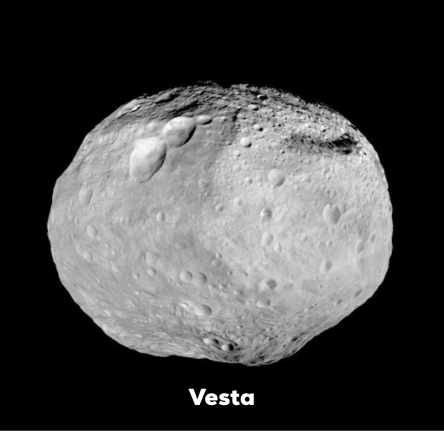
Asteroid. For many that word brings to mind planet killing space rocks. We all know that it was a giant asteroid that delivered the coup de grace to the dinosaurs some 66 million years ago. A paper published in the journal Science Advances last month, kind of seals the deal with geochemists reporting the finding of iridium (“asteroid dust”) inside the Chicxulub Crater off the Yucatan Peninsula. The crater has long been thought to be the impact site of the dinosaur killing object (in fact, it was the uncle of UA Little Rock biology professor, William Baltosser, who first identified it as an asteroid impact site many years ago). Watch any TV documentary about dinosaurs or asteroids and you are bound to see dramatic CGI renderings of this cataclysmic extinction level, event. And yes, right this very moment, there is an asteroid or comet out there somewhere with Earth’s name on it. Settle down, we don’t know of any that pose an immediate threat to our existence, but astronomers are constantly vigilant. As I write this, according to NASA’s Minor Planet Center (minor planets are objects that orbit the Sun and are neither “true” planets nor comets), there are currently 1,064,408 known asteroids, and more are being discovered every day. 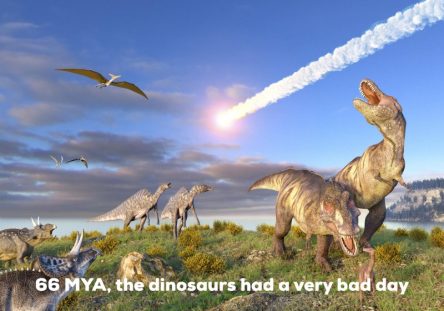
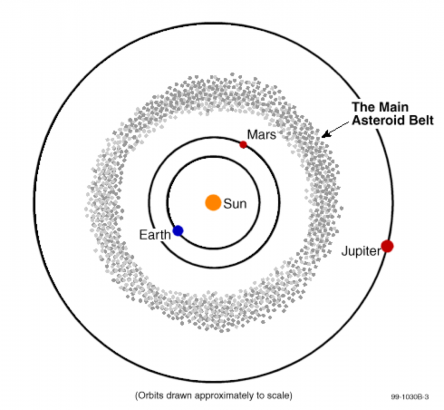
Most of this rocky and metallic debris, which is leftover planet-making material from 4.6 billion years ago, when the solar system was just forming, is content to just hang out, minding their own business, in between the orbits of Mars and Jupiter. We call it the “asteroid belt” or, the “Main Belt”. The belt lies between 2.2 to 3.2 Astronomical Units (AU) from the Sun. One AU is the Earth-Sun distance and is about 93 million miles. So, the belt is about 93 million miles wide or, 1 AU. Contrary to what Han Solo might tell you, the asteroid belt (at least our asteroid belt) is not jam packed with space rocks, the average distance separating individual asteroids is about 600,000 miles. Asteroids range in size from a few meters across to the largest known, Ceres, at some 587 miles across. This is large enough for gravity to have pulled Ceres into a sphere-shape and astronomers tend to think of it as a dwarf planet, the only one to exist inside the belt. Now, the vast majority of us have never seen an asteroid “in the wild” but I’m going to tell you how you can see one of these resident rocks of the Main Belt this month: Vesta, the second most massive object in the belt. And all you need is a pair of binoculars. Let’s go!
HOW TO FIND AND OBSERVE IT
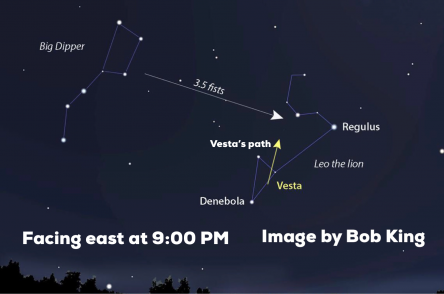
Ordinarily, hunting down an asteroid is a challenging endeavor to say the least but, with Vesta this month, we will have a little help from a lion. Throughout March, Vesta will be cruising along through Leo’s hindquarters so our first order of business will be to go lion hunting. Finding Leo is a snap.
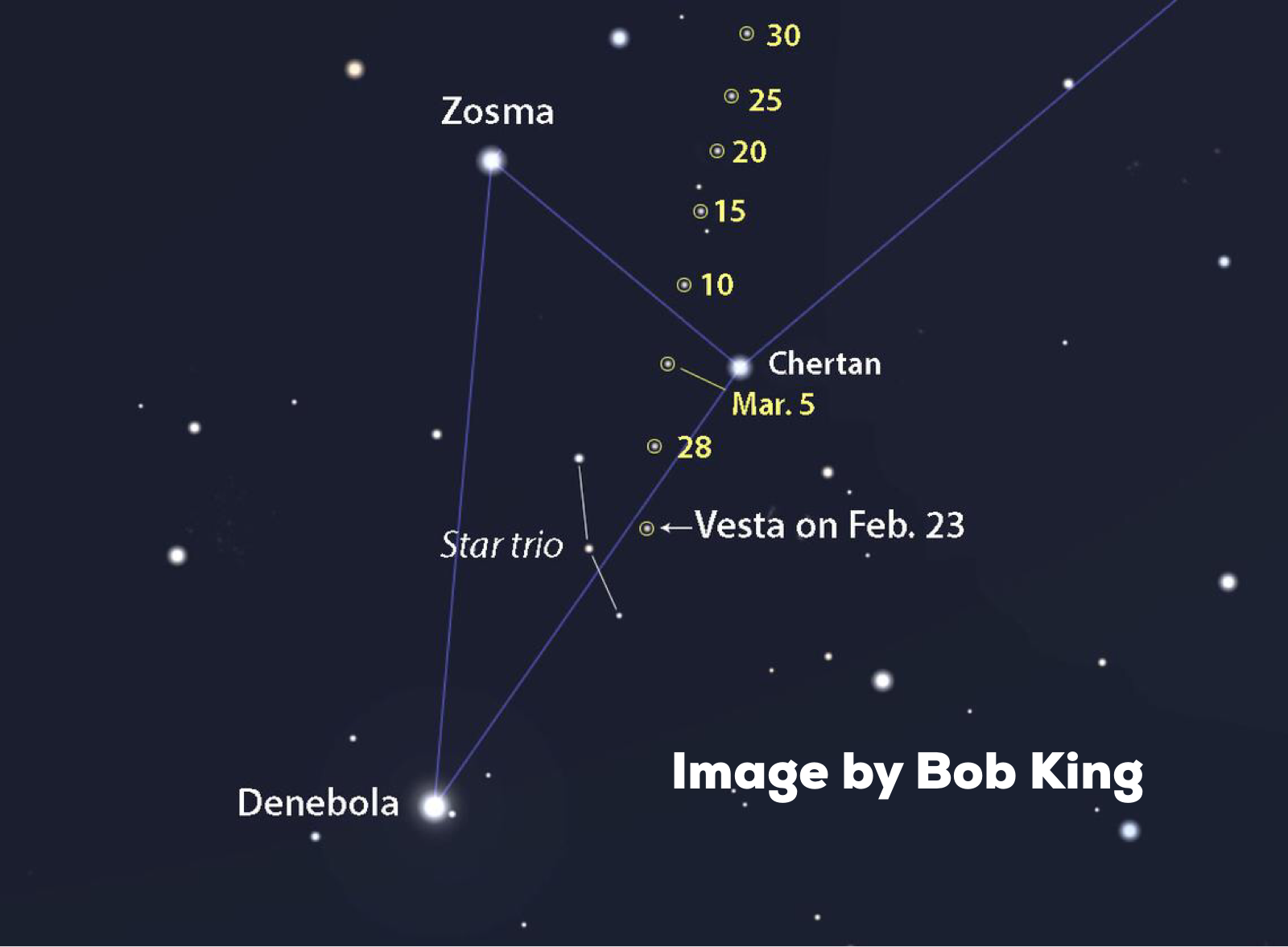 STEP 1: All you need do is go outside at around 9:00 PM and face east (as the Earth spins upon its axis, Leo and all the other constellations will shift further towards the west with each passing hour). The brightest star you see in this part of the sky at that time is Regulus, the heart of Leo and the brightest star in the constellation. If you are in doubt, look above Regulus and you should see a backward facing question mark-shape made up of six stars. This is Leo’s mane, but it also goes by the name “The Sickle” because it does look a bit like a scythe.
STEP 1: All you need do is go outside at around 9:00 PM and face east (as the Earth spins upon its axis, Leo and all the other constellations will shift further towards the west with each passing hour). The brightest star you see in this part of the sky at that time is Regulus, the heart of Leo and the brightest star in the constellation. If you are in doubt, look above Regulus and you should see a backward facing question mark-shape made up of six stars. This is Leo’s mane, but it also goes by the name “The Sickle” because it does look a bit like a scythe.
STEP 2: Now, make a fist and hold it out at arm’s length (don’t worry about feeling silly, all the cool astronomy kids are doing it). Hold your outstretched fist up to Regulus. Next, tilt your fist to the left so that it forms a diagonal line against the sky.
STEP 3: Approximately two fist lengths to the left along this diagonal line and you will come to Leo’s second brightest star, Denebola, which marks the location of the lion’s tail (the name is a shortening of the Arabic “Deneb Alased”, “the lion’s tail”). If you are in doubt, look for two other stars that make a triangle-shape along with Denebola and which denote the lion’s hindquarters: Zosma and Chertan. Denebola, Chertan, and Zosma will be your guide stars for locating Vesta all this month. Use the graphic that I have included to show you where Vesta is throughout March.
As do the planets, so to do asteroids orbit around the Sun. Also, like the planets, they do not generate their own light, instead, they reflect sunlight. On March 4th, Vesta reaches opposition in our sky. Opposition just means that it is at a point in its orbit to where the Sun, the Earth, and Vesta are all more or less aligned together, placing Vesta at (or, near enough) its closest distance from us. At opposition, Vesta will be shining at a magnitude of 6 and that puts it right at the threshold of naked eye visibility. With good eyesight, and a dark enough sky, you could see it without optical aid. However, the rest of us will need some help. On a moonless night, armed with just binoculars (even a pair of 7×35’s will do just dandy), you can pick it out against the background stars using the accompanying graphic to guide you. You should be able to see it even in suburban skies. If you use a telescope, I suggest first using the binoculars to spot it and then move on to the scope. Always begin your telescope observations using the lowest power eyepiece in order to have the widest field of view.

What will you see? Well don’t expect to see a rock tumbling along through space. Instead, all you are going to see is a bright, star-like light (the word “asteroid” in fact means “star-like”). It’s in knowing what you are looking at that makes the view all the more interesting.
WHAT ARE YOU SEEING?
 In the 18th century, astronomers noted the gap in between the orbits of Mars and Jupiter and predicted that the space must be occupied by an as yet unknown planet. It wasn’t until 1801 that the first asteroid, Ceres, was discovered. More and more asteroid discoveries followed, and it was thought that they were the fragments of a shattered planet. We now know that they are actually a stillborn planet. Jupiter’s gravity keeps the belt stirred and the accretion process of planet building could just never take place. During the first few million years of its history, the solar system was a crowded and violent place where planetesimal collisions occurred on a regular basis. A current theory known as The Grand Tack Model (“tacking” is a nautical term referring to a sailing maneuver that changes the direction of a boat by turning the bow into the wind and then shifting the sails), posits that during this time, Jupiter and Saturn wandered a ways into the inner solar system for a spell before reversing course and moving back out again to their present locations. This migration of the gas giants scattered the occupants of the Main Belt into various regions of the solar system, resulting in a large number of impacting bodies slamming into the moon and Earth (the moon bears those scars to this day). Today, there is not enough material left over to even form something the size or our moon.
In the 18th century, astronomers noted the gap in between the orbits of Mars and Jupiter and predicted that the space must be occupied by an as yet unknown planet. It wasn’t until 1801 that the first asteroid, Ceres, was discovered. More and more asteroid discoveries followed, and it was thought that they were the fragments of a shattered planet. We now know that they are actually a stillborn planet. Jupiter’s gravity keeps the belt stirred and the accretion process of planet building could just never take place. During the first few million years of its history, the solar system was a crowded and violent place where planetesimal collisions occurred on a regular basis. A current theory known as The Grand Tack Model (“tacking” is a nautical term referring to a sailing maneuver that changes the direction of a boat by turning the bow into the wind and then shifting the sails), posits that during this time, Jupiter and Saturn wandered a ways into the inner solar system for a spell before reversing course and moving back out again to their present locations. This migration of the gas giants scattered the occupants of the Main Belt into various regions of the solar system, resulting in a large number of impacting bodies slamming into the moon and Earth (the moon bears those scars to this day). Today, there is not enough material left over to even form something the size or our moon.
 Vesta was discovered in 1807 by German astronomer Heinrich Wilhelm Matthias Olbers. He decided to name it Vesta, after the Roman goddess of the hearth and home. Perhaps an apt name in hindsight because in its time, Vesta has seen a whole lot of shaking and baking. Back in 2011 and 2012, NASA’s Dawn spacecraft visited Vesta and it found that the 326.47-mile-wide asteroid was nearly spherical in shape and, most interestingly, had undergone a process known as differentiation. In other words, Vesta had a metallic core, a mantle and a crust. If that sounds familiar it should, you are living on a world that has done just the same thing, as has all the rocky planets of the solar system (as well as a number of rocky moons). Apparently, Vesta had started down the planet making path early on in the solar system’s history until Jupiter’s gravitational sway put a stop to it. When you look at Vesta in binoculars or a small scope, you are looking at the only intact, layered planetary building block surviving from the very earliest days of the solar system. Any other objects like Vesta were probably incorporated into proper planets or destroyed via collisions long, long ago. How cool is that?
Vesta was discovered in 1807 by German astronomer Heinrich Wilhelm Matthias Olbers. He decided to name it Vesta, after the Roman goddess of the hearth and home. Perhaps an apt name in hindsight because in its time, Vesta has seen a whole lot of shaking and baking. Back in 2011 and 2012, NASA’s Dawn spacecraft visited Vesta and it found that the 326.47-mile-wide asteroid was nearly spherical in shape and, most interestingly, had undergone a process known as differentiation. In other words, Vesta had a metallic core, a mantle and a crust. If that sounds familiar it should, you are living on a world that has done just the same thing, as has all the rocky planets of the solar system (as well as a number of rocky moons). Apparently, Vesta had started down the planet making path early on in the solar system’s history until Jupiter’s gravitational sway put a stop to it. When you look at Vesta in binoculars or a small scope, you are looking at the only intact, layered planetary building block surviving from the very earliest days of the solar system. Any other objects like Vesta were probably incorporated into proper planets or destroyed via collisions long, long ago. How cool is that?
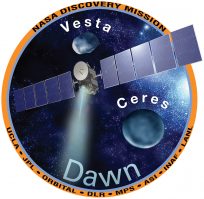 Results from the Dawn mission suggest that Vesta formed very early, say within 1 or 2 million years of the solar system’s formation. Built from the ground up, like all the planets, from the collisions between smaller objects that then snowballed into bigger objects, Vesta would have incorporated a lot of short-lived radioactive elements in its interior. This radioactivity would have melted Vesta, and, as it cooled, the heavier elements, like nickel and iron, would have sank towards the center, while lighter stuff would have floated to the surface: differentiation.
Results from the Dawn mission suggest that Vesta formed very early, say within 1 or 2 million years of the solar system’s formation. Built from the ground up, like all the planets, from the collisions between smaller objects that then snowballed into bigger objects, Vesta would have incorporated a lot of short-lived radioactive elements in its interior. This radioactivity would have melted Vesta, and, as it cooled, the heavier elements, like nickel and iron, would have sank towards the center, while lighter stuff would have floated to the surface: differentiation.
We’ve known for some time that Vesta displays a huge range in brightness but, until the Dawn mission, we didn’t know why. It now seems that, over the course of its history, poor Vesta has been subjected to a lot of violent collisions. Brighter materials appear to be native rock while the darker stuff comes from impacts by smaller, dark asteroids. Over the last 3.5 billion years, Vesta has been hit by at least 300 impactors, ranging in size from half a mile across to around 6 miles in diameter. These collisions have coated Vesta in dark material some 3 to 7 feet thick.
 You may have noticed those grooves girdling Vesta’s equatorial region. What’s up with that? I’m glad you asked. The largest of these grooves, named Divalia Fossa, is bigger than the Grand Canyon and gives further testimony to Vesta’s violent history. If you look at Vesta’s south pole, you can’t help but notice how flat it is. Except for that mountain sticking up from it. That mountain rises some 14 miles above the surface, making it twice as tall as Mount Everest. That flattened basin at the south pole, along with that one tall peak, is indicative of an impact. A big one, and one that could have obliterated Vesta all together. Fortunately for Vesta, the impactor must have hit it a glancing blow, rather than head on. Through computer modeling and laboratory experiments at NASA’s Ames Vertical Gun Range, where simulations are done by firing projectiles at very high speeds into solid materials, it is now believed that Vesta’s impactor severely cracked the asteroids interior. Moments after impact, the reverberations created those grooves, which are fault lines, all around Vesta’s equator.
You may have noticed those grooves girdling Vesta’s equatorial region. What’s up with that? I’m glad you asked. The largest of these grooves, named Divalia Fossa, is bigger than the Grand Canyon and gives further testimony to Vesta’s violent history. If you look at Vesta’s south pole, you can’t help but notice how flat it is. Except for that mountain sticking up from it. That mountain rises some 14 miles above the surface, making it twice as tall as Mount Everest. That flattened basin at the south pole, along with that one tall peak, is indicative of an impact. A big one, and one that could have obliterated Vesta all together. Fortunately for Vesta, the impactor must have hit it a glancing blow, rather than head on. Through computer modeling and laboratory experiments at NASA’s Ames Vertical Gun Range, where simulations are done by firing projectiles at very high speeds into solid materials, it is now believed that Vesta’s impactor severely cracked the asteroids interior. Moments after impact, the reverberations created those grooves, which are fault lines, all around Vesta’s equator.
Vesta may look like a mere star-like dot in your binoculars but stop to consider all the violence that point of light has seen over the last few billion years. Consider all the history it has borne witness to regarding the evolution of the solar system. And also consider its status as a planet-that-might-have-been. A lot to think about as you look up in both awe and wonder.